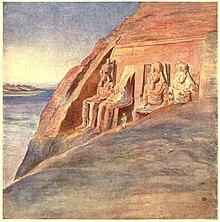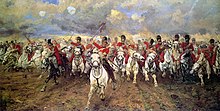Elizabeth Thompson
Elizabeth Southerden Thompson , from 1877 Elizabeth Butler (born November 3, 1846 in Lausanne , † October 2, 1933 in Gormanston , County Meath ) was a British war painter and one of the most successful painters of the 19th century who created a new realism in the representation of the Brought war into British art.

Life
Elizabeth Thompson was a daughter of Thomas James Thompson and his second wife Christiana, geb. Weller. She was a sister of the poet Alice Meynell (1847-1922).
Elizabeth Thompson was born in Switzerland, but grew up in Italy, where she was trained from 1862. In 1866 she continued her studies at the Female School of Art in South Kensington, and in 1869 the family moved to Florence. There Elizabeth Thompson worked under the guidance of Giuseppe Bellucci (1827-1882). In 1870 she moved to Paris. Her subject was initially mainly religious art, but now she came under the influence of Jean Louis Ernest Meissonier and Édouard Detaille . However, she had already dealt with battle pictures in 1868, as a sketchbook found in 2010 shows.
In 1871, the Secretary of War Edward Cardwell began the long-sought reorganization of the English army, which, among other things, abolished the ability to buy officers and brought about other urgent reforms.
Her painting Calling the Roll after an Engagement, Crimea , known as "The Roll Call", which shows the appeal for a battle during the Crimean War , was noticed at the Royal Academy in 1874 , she renounced the glorification of the war and instead represented suffering of war in the foreground. When "The Roll Call" was exhibited at the Royal Academy in May 1874, it was a sensation and Thompson became, practically overnight, one of the most renowned British military painters of the 19th century. Queen Victoria bought the picture and her work has been reproduced in thousands of prints. Although she became known through this painting and in the following years such as The 28th Regiment at Quatre Bras (1875), Balaclava (1876) and The Return from Inkerman (1877), her acceptance into the Academy failed because of two votes, it would be that first female member since founding members Angelika Kauffmann and Mary Moser . However, she exhibited repeatedly at the Royal Academy until the 1920s.
On June 11, 1877, Elizabeth Thompson married Sir William Francis Butler , who was from Ireland. From then on she was named Lady Butler, Elizabeth Southerden. The marriage to Butler had five children. She traveled extensively (1885-1892), including her time in Egypt where her husband served, and toured Palestine (1891). She published her book Letters from the Holy Land (1903).
During the First World War she still painted battle paintings, including a picture showing one of six footballs that British soldiers from the London Irish Rifles had taken to war with them to shoot them over enemy lines. While the remaining five balls were destroyed by the commanding officer before the Battle of Loos before this plan could be implemented, this sixth example could actually be used for playing during the war. Football later came to the Camberwell Regimental Museum , disappeared in an unexplained manner after about 50 years, and reappeared in 2011.
In 1922 Elizabeth Thompson published her autobiography.
Paintings (selection)
- 1874 The Roll Call (collection of Her Majesty the Queen);
- 1875 The 28th Regiment at Quatre Bras (National Gallery of Victoria, Melbourne);
- 1876 Balaclava (Manchester City Art Galleries);
- 1880 The Defense of Rorke's Drift (collection of HMQ);
- 1881 Scotland for Ever! (Leeds City Art Galleries);
- 1897 "Steady the drums and fifes!" (Collection of The Queens' Regiment, Canterbury).
- 1913 Charge of the Polish Lancers The Royal Collection Trust
- 1914 Awaiting the Answer - Orderly 7th (British) Hussars The Royal Collection Trust
- 1914 Towards the close of battle - God Save The King The Royal Collection Trust
Before her marriage, she signed her works "ET" or "EST" and then "EB"
Fonts
- Letters from the Holy Land . Published 1903
- From sketch-book and diary . Published 1909
- To autobiography Publisher: Constable & Co. Ltd., London 1922
Web links
- Elizabeth Southerden (née Thompson), Lady Butler (1846-1933), Military painter; wife of Sir William Francis Butler in National Portrait Gallery, London
- Full page on Thompson's works
- Books by Lady Elizabeth Butler - on the Internet Archive
- Elizabeth Thompson (Lady Butler) Biography by John Simkin in: Spartacus educational
- Elizabeth Thompson (Lady Butler) Biography By Krzysztof Z. Cieszkowski in: The British Empire
- Paintings by Elizabeth Southerden Thompson Butler on BBC Your paintings
- Elizabeth Southerden Thompson Biography by Kara Lysandra Ross with some pictures in: Art Renewal Center
Individual evidence
- ↑ Elizabeth Thompson Bio and photo ( Memento of the original from July 24, 2008 in the Internet Archive ) Info: The archive link was automatically inserted and not yet checked. Please check the original and archive link according to the instructions and then remove this notice.
- ↑ Sketchbook discovered
- ↑ Cardwell's Army Reforms 1870-1881
- ↑ Prints of her paintings ( Memento of the original from July 14, 2011 in the Internet Archive ) Info: The archive link was inserted automatically and has not yet been checked. Please check the original and archive link according to the instructions and then remove this notice.
- ↑ www.royalacademy.org.uk: Bombs, dots and rockstars: seven stories of the Summer Exhibition
- ↑ [1] ( Page no longer available , search in web archives ) Info: The link was automatically marked as defective. Please check the link according to the instructions and then remove this notice.
- ↑ To autobiography Publisher: Constable & Co. Ltd., London 1922
- ^ Butler, Elizabeth Thompson - Women in World History: A Biographical Encyclopedia
| personal data | |
|---|---|
| SURNAME | Thompson, Elizabeth |
| ALTERNATIVE NAMES | Butler, Elizabeth; Thompson, Elizabeth Southerden |
| BRIEF DESCRIPTION | British battle painter |
| DATE OF BIRTH | November 3, 1846 |
| PLACE OF BIRTH | Lausanne |
| DATE OF DEATH | October 2, 1933 |
| Place of death | Gormanston |


